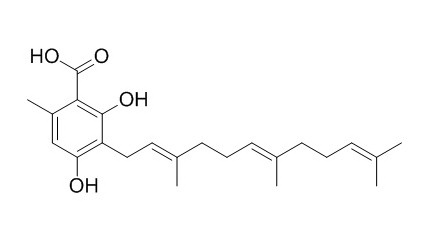Grifolic acid
Grifolic acid is a natural carbonic anhydrase II inhibitor(CAII), it shows in-hibitory activities against CAII with IC50 of 6.37 umol/L. Grifolic acid has antibacterial activity, it can inhibit the growth of Staphylococcus aureus and Staphylococcus epidermidis.
Inquire / Order:
manager@chemfaces.com
Technical Inquiries:
service@chemfaces.com
Tel:
+86-27-84237783
Fax:
+86-27-84254680
Address:
1 Building, No. 83, CheCheng Rd., Wuhan Economic and Technological Development Zone, Wuhan, Hubei 430056, PRC
Providing storage is as stated on the product vial and the vial is kept tightly sealed, the product can be stored for up to
24 months(2-8C).
Wherever possible, you should prepare and use solutions on the same day. However, if you need to make up stock solutions in advance, we recommend that you store the solution as aliquots in tightly sealed vials at -20C. Generally, these will be useable for up to two weeks. Before use, and prior to opening the vial we recommend that you allow your product to equilibrate to room temperature for at least 1 hour.
Need more advice on solubility, usage and handling? Please email to: service@chemfaces.com
The packaging of the product may have turned upside down during transportation, resulting in the natural compounds adhering to the neck or cap of the vial. take the vial out of its packaging and gently shake to let the compounds fall to the bottom of the vial. for liquid products, centrifuge at 200-500 RPM to gather the liquid at the bottom of the vial. try to avoid loss or contamination during handling.
J Ethnopharmacol.2020, 254:112733.
Food Analytical Methods2017, 10:3225-3234
Anat Rec (Hoboken).2021, 304(2):323-332.
Korean J. Medicinal Crop Sci2021, 10:345-352.
British Jou. Med.&Med. Research2014, 1802-1811
J Colloid Interface Sci.2024, 662:760-773.
Chem Biol Interact.2024, 395:110999.
Naunyn Schmiedebergs Arch Pharmacol.2024, 03148-x.
Horticulturae2020, 6(4),76.
Journal of Mushroom2023, 21(4):215-221.
Related and Featured Products
Endocrinology. 2015 Mar;156(3):837-46.
Free fatty acid receptor GPR120 is highly expressed in enteroendocrine K cells of the upper small intestine and has a critical role in GIP secretion after fat ingestion.[Pubmed:
25535828]
Gastric inhibitory polypeptide (GIP) is an incretin secreted from enteroendocrine K cells in response to meal ingestion. Recently free fatty acid receptor G protein-coupled receptor (GPR) 120 was identified as a lipid sensor involved in glucagon-like peptide-1 secretion. However, Gpr 120 gene expression and its role in K cells remain unclear, partly due to difficulties in separation of K cells from other intestinal epithelial cells.
METHODS AND RESULTS:
In this study, we purified K cells using GIP-green fluorescent protein (GFP) knock-in mice, in which K cells can be visualized by GFP fluorescence. GFP-positive cells (K cells) were observed in the small intestine but not in the stomach and colon. K cell number and GIP content in K cells were significantly higher in the upper small intestine than those in the lower small intestine. We also examined the expression levels of several free fatty acid receptors in K cells. Among free fatty acid receptors, GPR120 was highly expressed in the K cells of the upper small intestine compared with the lower small intestine. To clarify the role of GPR120 on K cells in vivo, we used GPR120-deficient mice (GPR120(-/-)). GPR120(-/-) exhibited significantly lower GIP secretion (75% reduction, P < .01) after lard oil ingestion compared with that in wild-type mice. Consistently, pharmacological inhibition of GPR120 with Grifolic acid methyl ether in wild-type mice significantly attenuated lard oil-induced GIP secretion.
CONCLUSIONS:
In conclusion, GPR120 is expressed abundantly in K cells of the upper small intestine and plays a critical role in lipid-induced GIP secretion.
J Ethnopharmacol. 2004 Oct;94(2-3):279-81.
Use of a modified microplate bioassay method to investigate antibacterial activity in the Peruvian medicinal plant Peperomia galioides.[Pubmed:
15325731 ]
METHODS AND RESULTS:
A versatile microplate bioassay for quick and sensitive determination of antibacterial activity was developed for use in screening medicinal plants and identification of their active principles. This assay can be used to determine minimum inhibitory concentrations for small quantities of organic or water-soluble plant extracts.
CONCLUSIONS:
Bioassay-guided fractionation of the stem and leaves of Peperomia galioides using this method found fractions containing grifolin and Grifolic acid, which inhibited growth of Staphylococcus aureus and Staphylococcus epidermidis.
Science China Chemistry,2009, 52(3):332-7.
Screening and docking studies of natural phenolic inhibitors of carbonic anhydrase II.[Reference:
WebLink]
Carbonic anhydrase II (CA II) is an important enzyme complex with Zn2+, which is involved in many physiological and pathological processes, such as calcification, glaucoma and tumorigenicity.
METHODS AND RESULTS:
In order to search for novel inhibitors of CA II, inhibition assay of carbonic anhydrase II was performed, by which seven natural phenolic compounds, including four phenolics (grifolin, 4-O-methyl-Grifolic acid, Grifolic acid, and isovanillic acid) and three flavones (eriodictyol, quercetin and puerin A), showed inhibitory activities against CA II with IC50s in the range of 6.37–71.73 μmol/L. Grifolic acid is the most active one with IC50 of 6.37 μmol/L. These seven phenolic compounds were proved to be novel natural carbonic anhydrase II inhibitors, which were obtained in flexible docking study with GOLD 3.0 software.
CONCLUSIONS:
Results indicated that the aliphatic chain and polar groups of hydroxyl and carboxyl are important to their inhibitory activities, providing a new insight into study on CA II potent inhibitors.



